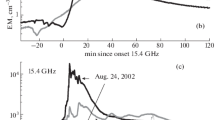Abstract
Giant X-ray events (>X17) in the 23rd solar cycle (October 28 and November 4, 2003, and September 7, 2005) are considered, which were almost completely observed in hard X rays (>150 keV) from the INTEGRAL satellite and partly from the RHESSI satellite. These events are compared with two events completely observed from the RHESSI satellite (X8.2 on November 2, 2003, and X7.1 on January 20, 2005). Time profiles of the plasma temperature, calculated from the GOES data on soft X rays during these events, have similar structures. This allowed us to choose a zero time point in each event and compare the dynamics of their evolution. Nonthermal radiation began approximately 10 min before the zero time point (preflare phase). During about 20 min after the zero point, bursts of nonthermal radiation were observed in all the three events, which pointed to several episodes of electron acceleration with variable spectra and plasma heating with different efficiency. It is shown that giant events are characterized by a large emission measure and a relatively low temperature of the flare plasma but not intensive acceleration processes. Observations of γ radiation from the decay of π0-mesons show that protons are accelerated to relativistic energies 4 min after the chosen zero point.
Similar content being viewed by others
References
Alexander, D. and Daou, A.G., Saturation of nonthermal hard X-ray emission in solar flare, Astrophys. J., 2007, vol. 666, pp. 1268–1276.
Brodrick, D., Tingay, S., and Wieringa, M., X-ray magnitude of the 4 November 2003 solar flare inferred from the ionospheric attenuation of the galactic radio background, J. Geophys. Res., 2005, vol. 110A, p. A09S36.
Dunphy, P.P., Chupp, E.L., Bertsch, D.L., et al., Gammarays and neutrons as a probe of flare proton spectra: The solar flare of 11 June 1991, Sol. Phys., 1999, vol. 187, no. 1, pp. 45–57.
Grechnev, V., Kurt, V., Chertok, I., et al., An extreme solar event of 20 January 2005: Properties of the flare and the origin of energetic particles, Sol. Phys., 2008, vol. 252, p. 149.
Holman, G.D., Sui, L., Schwartz, R.A., et al., Electron bremsstrahlung hard X-ray spectra, electron distributions, and energetics in the 2002 July 23 solar flare, Astrophys. J., 2003, vol. 595, pp. L97–L101.
Hudson, H.S., Global properties of solar flares, Space Sci. Rev., 2011, vol. 158, no. 1, pp. 5–41.
Hurford, G.J., Krucker, S., Lin, R.P., et al., Gamma-ray imaging of the 2003 October / November solar flares, Astrophys. J., 2006, vol. 644, pp. L93–L95.
Kahler, S.W., Meekins, J.F., Kreplin, R.W., and Bowyer, C.S., Temperature and emission-measure profiles of two solar X-ray flares, Astrophys. J., 1970, vol. 162, pp. 293–304.
Kane, S., McTiernan, J., and Hurley, K., Multispacecraft observations of the hard X-ray emission from the giant solar flare on 2003 November 4, Astron. Astrophys., 2005, vol. 433, pp. 1133–1138.
Kiplinger, A.L., Comparative studies of hard X-ray spectral evolution in solar flares with high-energy proton events observed at Earth, Astrophys. J., 1995, vol. 453, pp. 973–986.
Kiplinger, A.L. and Garcia, H.A., Soft X-ray parameters of the great flares of active region 486, BAAS, 2004, vol. 36, pp. 739–739.
Kontar, E. and Brown, J., A solar flare hard X-ray spectra possibly inconsistent with the collisional thick target model, Adv. Space Res., 2006, vol. 38, issue 5, pp. 945–950.
Kurt, V.G., Yushkov, B., Kudela, K., and Galkin, V.I., High-energy gamma radiation of solar flares as an indicator of acceleration of energetic protons, Cosmic Res., 2010a, no. 1, pp. 70–79.
Kurt, V.G., Svertilov, S.I., Yushkov, B.Yu., Bogomolov, A.V., Grechnev, V.V., Galkin, V.I., Bogomolov, V.V., Kudela, K., Logachev, Yu.I., Morozov, O.V., and Myagkova, I.N., Dynamics and energetics of the thermal and nonthermal components of the solar flare that occurred on January 20, 2005, according to data from hard electromagnetic emission detectors on the CORONAS-F satellite, Astron. Lett.,, 2010b, vol. 36, no. 4, pp. 280–291.
Lin, R.P., Krucker, S., Hurford, G.J., et al., RHESSI observations of particle acceleration and energy release in an intense solar gamma-line flare, Astrophys. J., 2003, vol. 595, pp. L69–L76.
Livshits, M.A. and Badalyan, O.G., Relation between impulsive and post-eruptive processes in solar X-ray flares, Astron. Rep., vol. 48, no. 12, pp. 1037–1049.
Neupert, W.M., Comparison of solar X-ray line emission with microwave emission during flares, Astrophys. J., 1968, vol. 153, pp. L59–L64.
Saldanha, R., Krucker, S., and Lin, R.P., Hard X-ray spectral evolution and production of solar energetic particle events during the January 2005 X-class flares, Astrophys. J., 2008, vol. 673, no. 2, pp. 1169–1173.
Struminsky, A.B., A Source of solar protons: the temperature of flare plasma and injection moments, Bull. Russ. Acad. Sci., Physics, 2011, vol. 75, no. 6, pp. 751–754.
Struminsky, A.B. and Zimovets, I.V., Development dynamics of intense solar proton flares, Astron. Lett., vol. 33, no. 9, pp. 615–621.
Struminsky, A.B. and Zimovets, I.V., Time of arrival of the first relativistic protons, Bull. Russ. Acad. Sci., Physics, 2009, vol. 73, no. 3, pp. 315–318.
Zuccarello, F., Romano, P., Farnik, F., et al., The X17.2 flare occurred in NOAA 10486: An example of filament destabilization caused by a domino effect, Astron. Astrophys., 2009, vol. 493, pp. 629–637.
Author information
Authors and Affiliations
Corresponding author
Rights and permissions
About this article
Cite this article
Struminsky, A.B. Giant events in the 23rd solar cycle: Common and specific features. Geomagn. Aeron. 53, 843–851 (2013). https://doi.org/10.1134/S0016793213070190
Received:
Published:
Issue Date:
DOI: https://doi.org/10.1134/S0016793213070190




